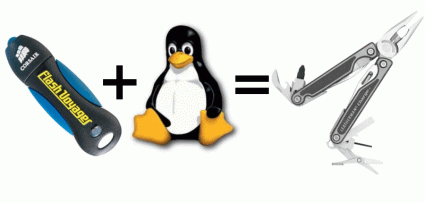Knoppix Linux On USB
Conclusion
For Windows installations, Feather Linux and DSL both feature several useful applications for repairing or recovering information on NTFS drives. The chntpw utility changes NT system passwords from Linux, captive NTFS drivers enable reads and writes to NTFS partitions, and rdesktop provides remote network administration using a Linux-compatible application. It supports GTKrecover, a graphical file recovery tool with file creation time granularity and a wealth of search features for discovering lost data, and gcombust to create a CD or DVD copy for archival use. And of course, the usual line-up of Linux-related repair utilities are on board to service a variety of Linux installation problems.
Where do you go from here? Anywhere! In and of itself, a portable USB rescue kit is an excellent multi-purpose tool for Windows and Linux machines that support bootstrapping from USB devices. Further modifications to the Knoppix platform are also possible. In fact, there are many publicly available examples, ranging from standards-compliant forensic analysis suites to graphical information systems and specialized computational platforms. The only limit on what you can use this type of tool to accomplish is the time and effort you want to spend building - and learning how to use it, of course.
Author's Opinion: Justin Korelc
Portable Knoppix distributions have become the all-purpose toolkit for a variety of applications, so it's only natural to find them in service as live demonstrations from proof-of-concept exhibitions to practical rescue and repair utilities. DSL and Feather offer similar packages and applications for repairing Windows or Linux installations. While DSL does have its own unique packaging scheme, either distribution may be modified easily to include other applications and packages to work on damaged OS installations.
Join our discussion on this topic
Speak out in the Toms's Hardware reader survey!
Get Tom's Hardware's best news and in-depth reviews, straight to your inbox.
Ed Tittel is a long-time IT writer, researcher and consultant, and occasional contributor to Tom’s Hardware. A Windows Insider MVP since 2018, he likes to cover OS-related driver, troubleshooting, and security topics.

